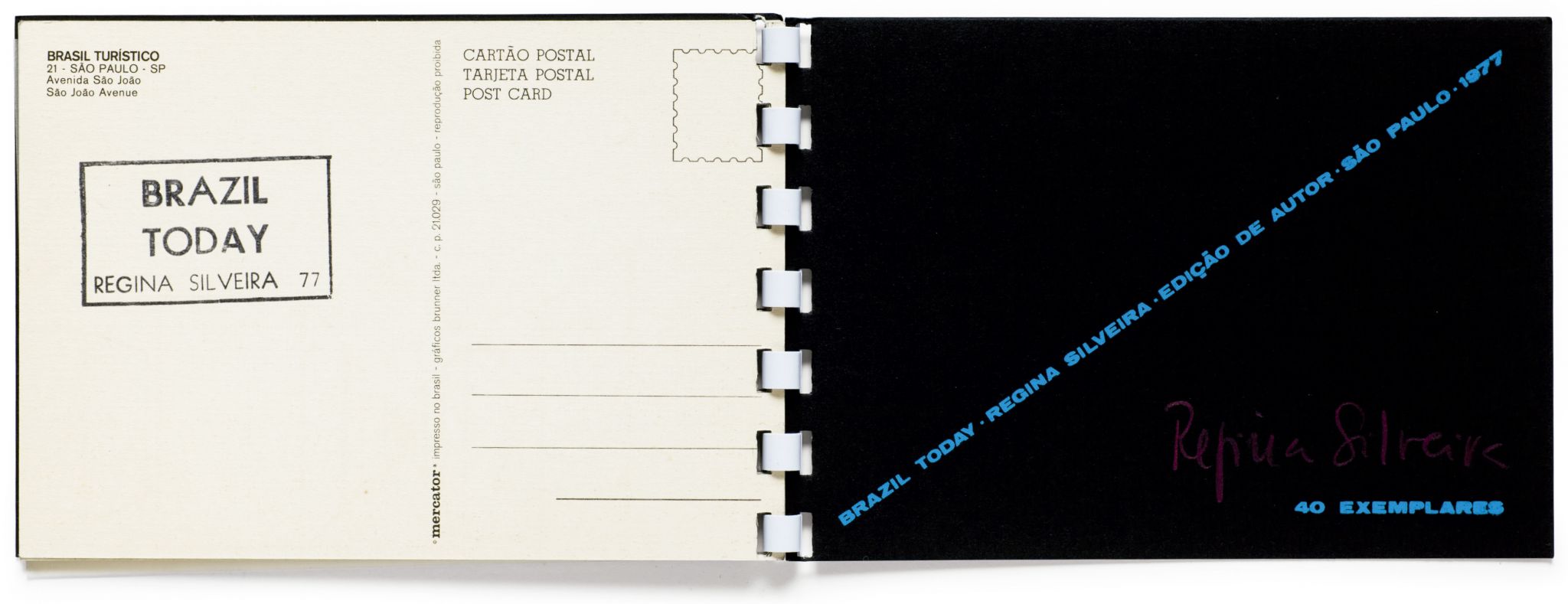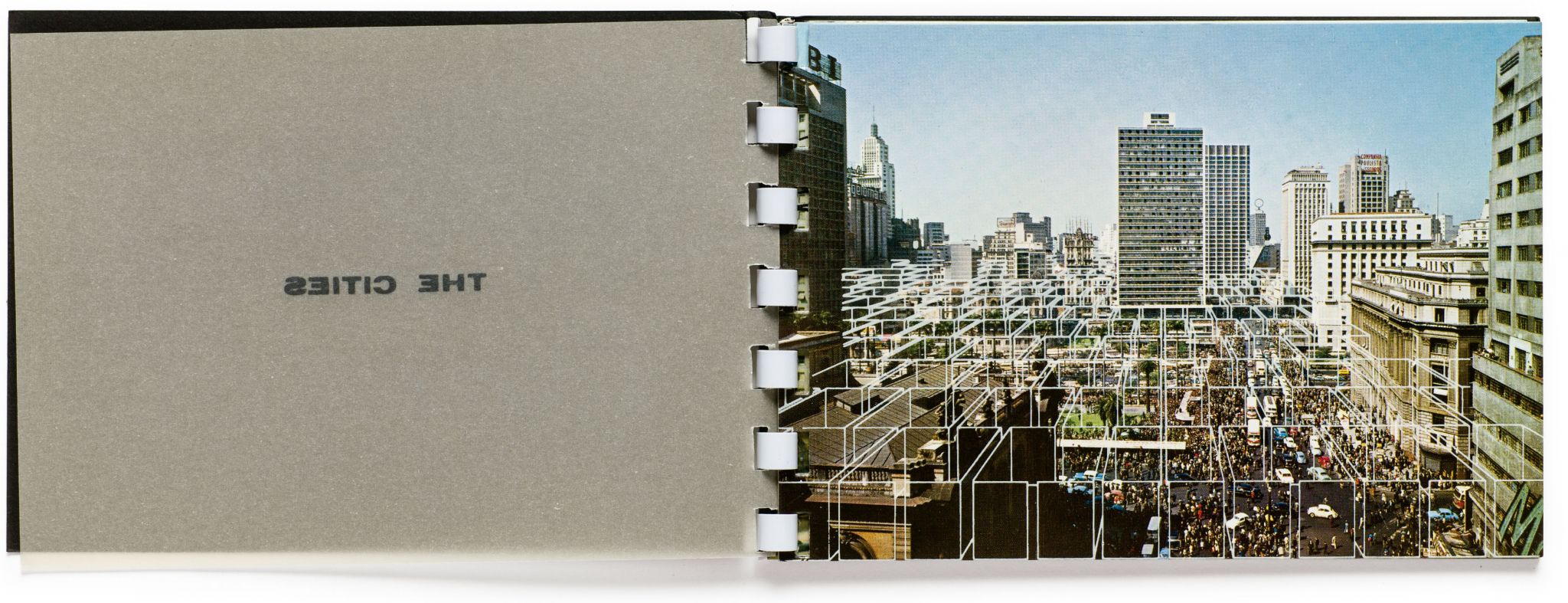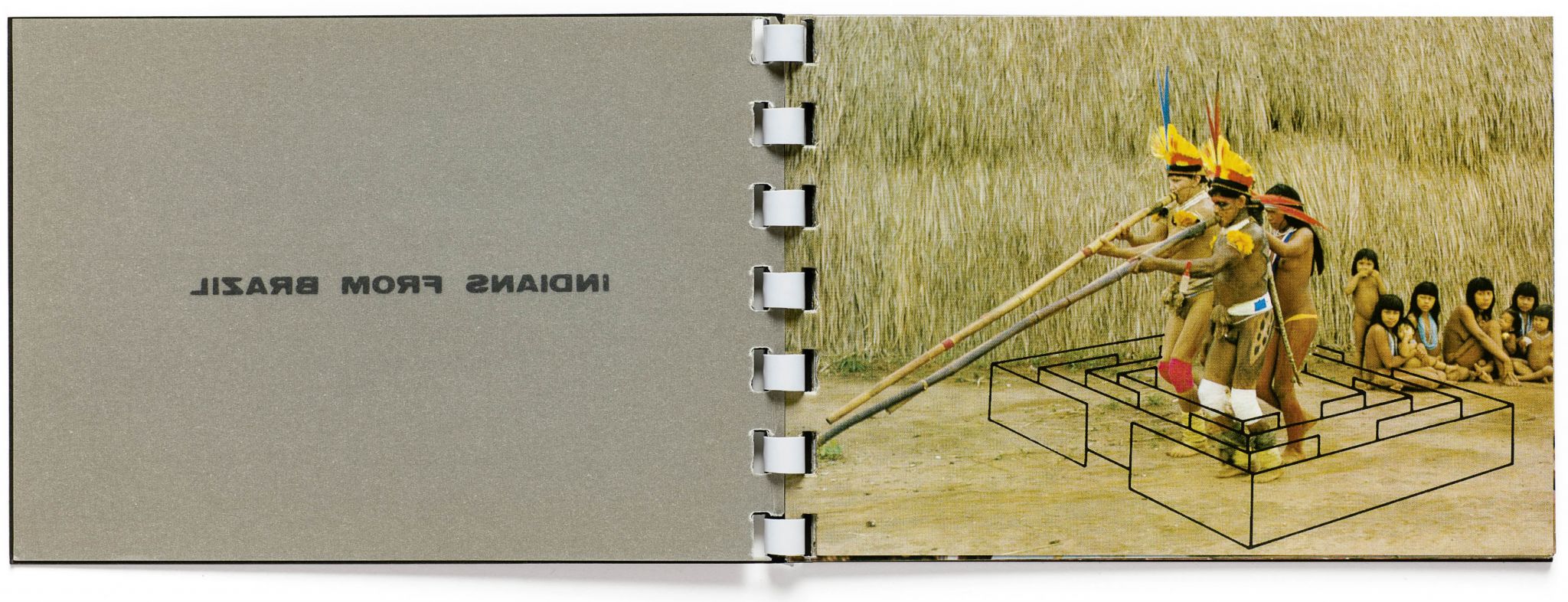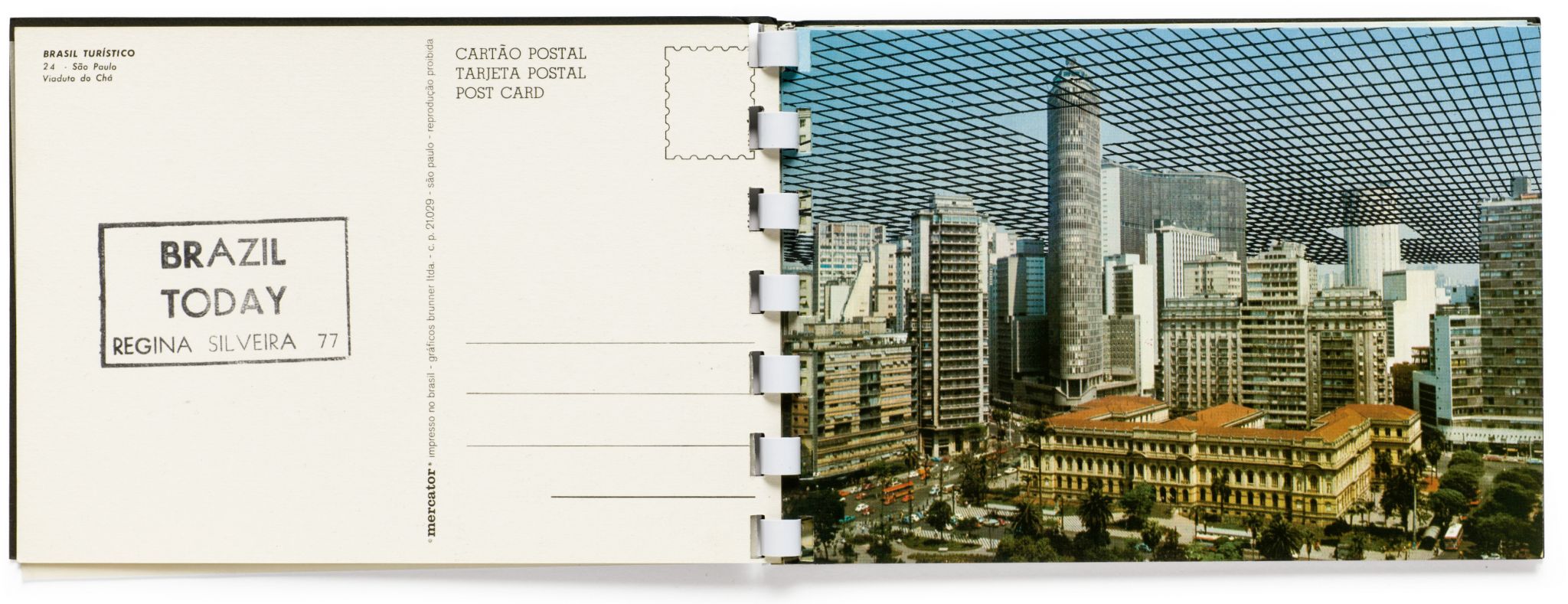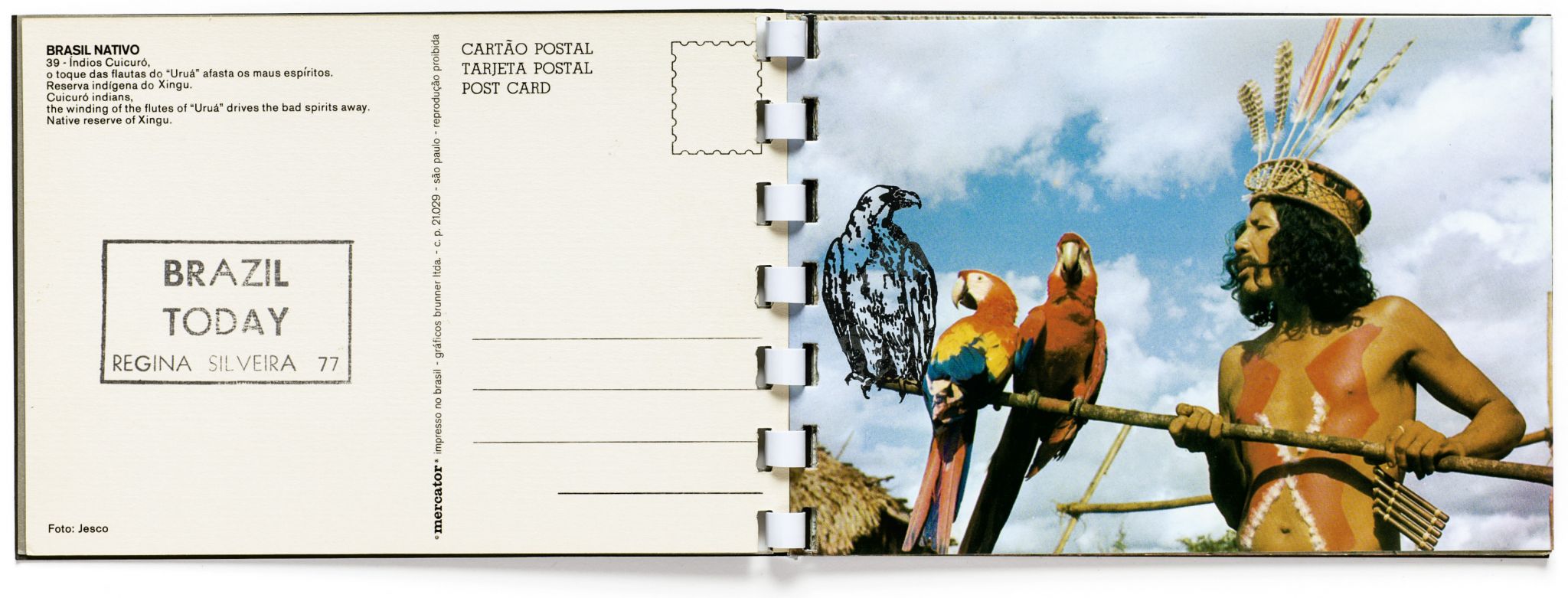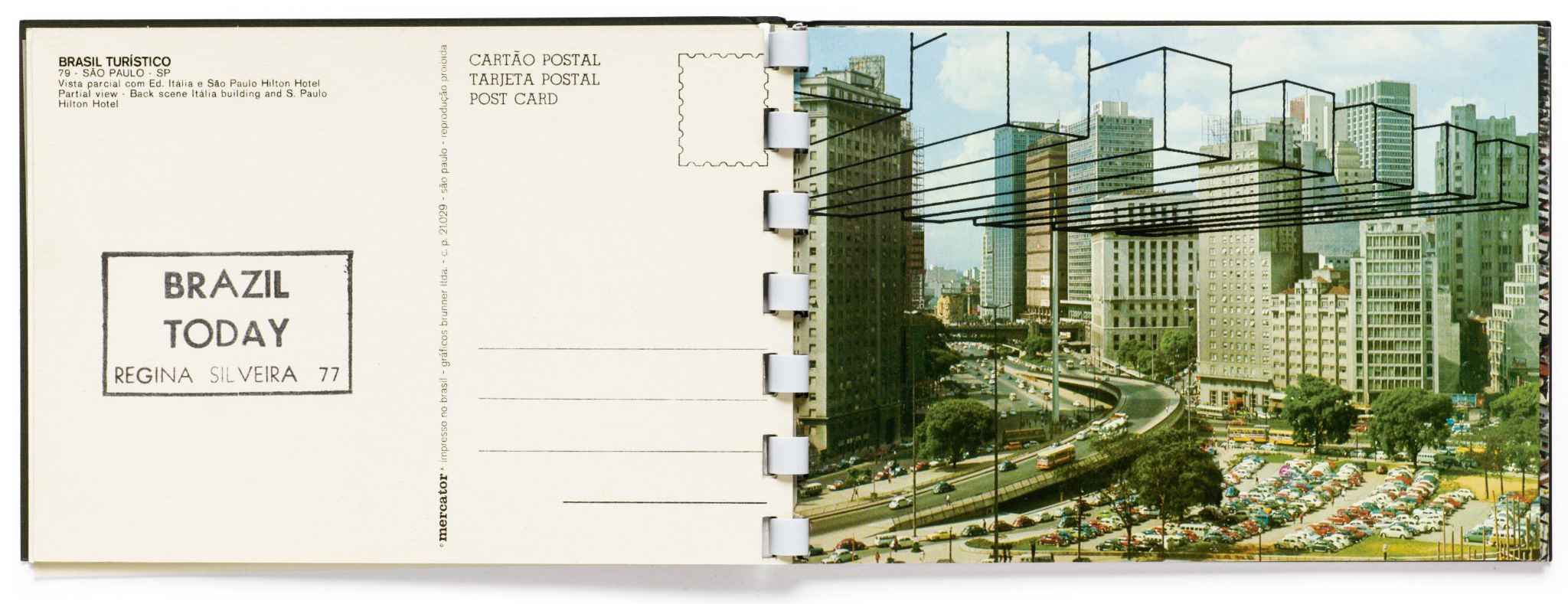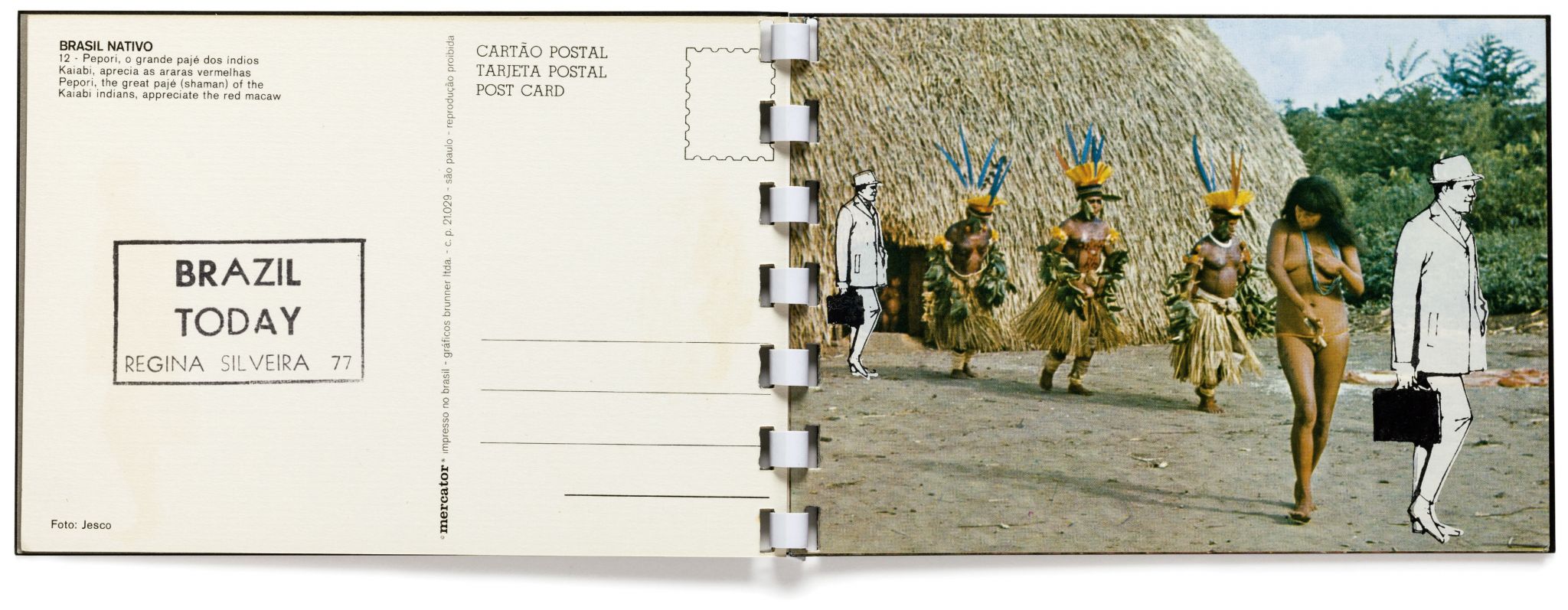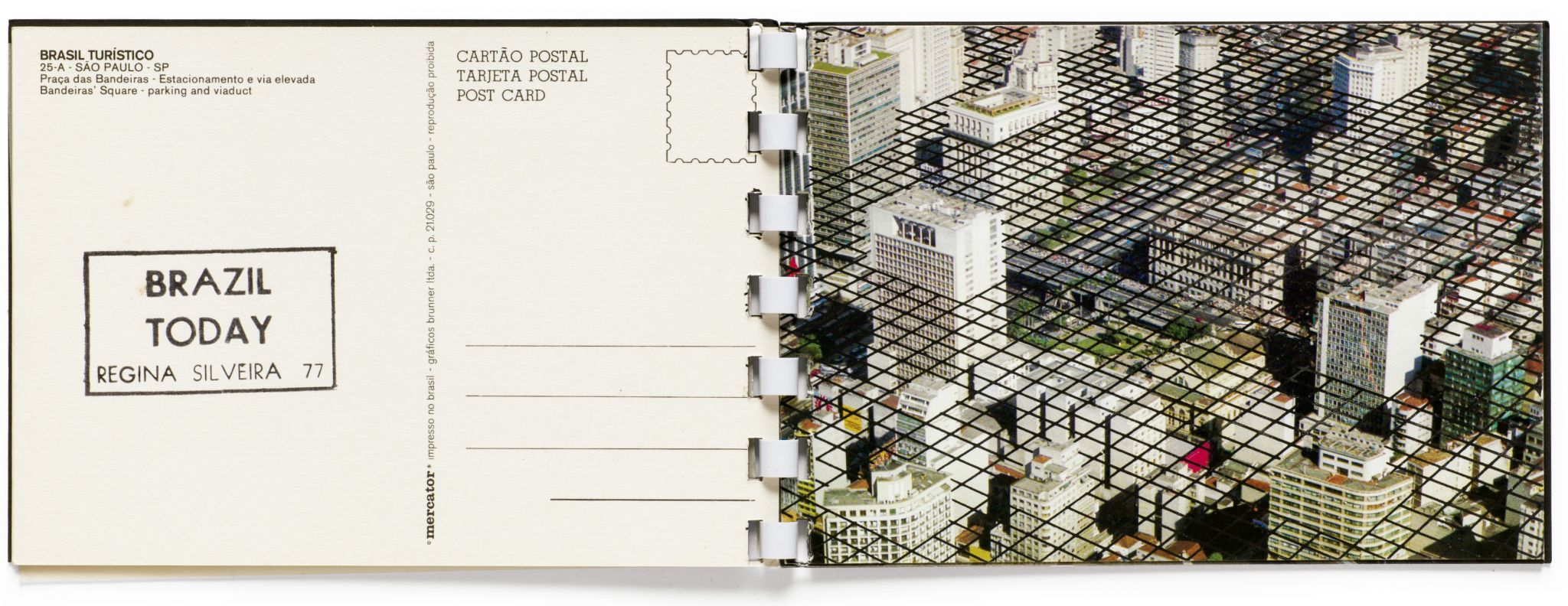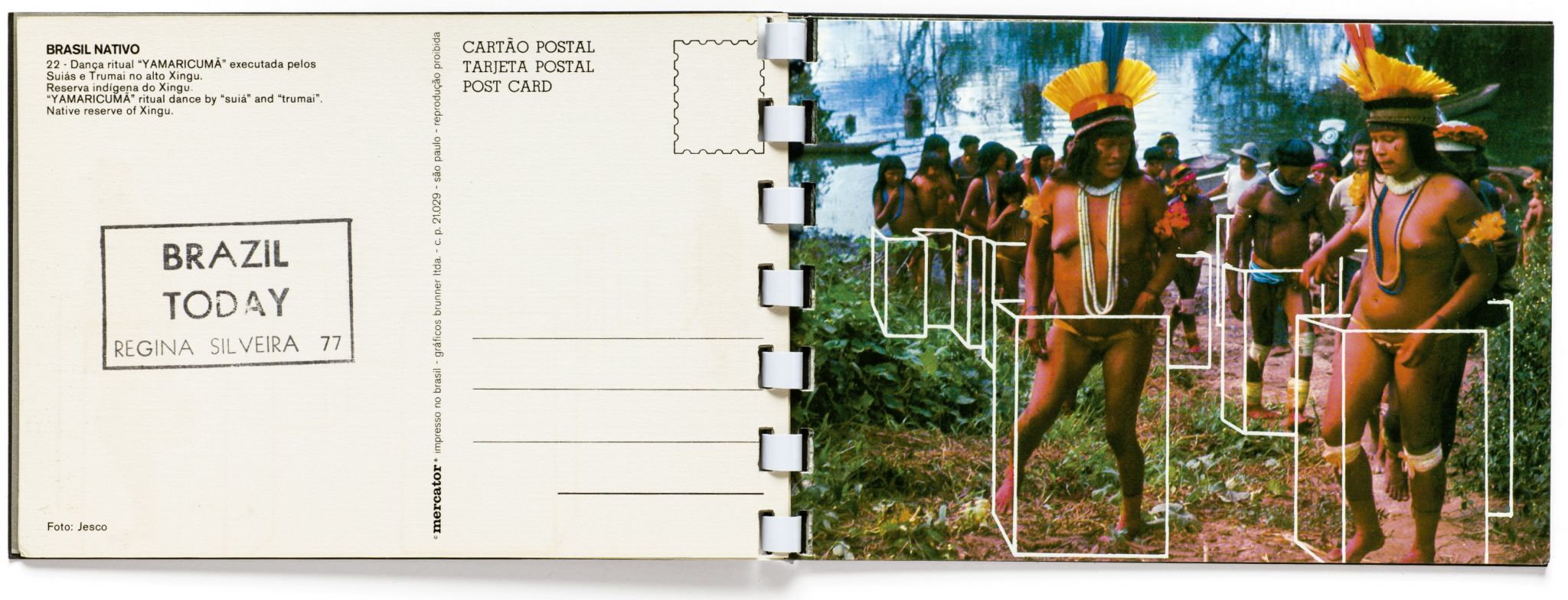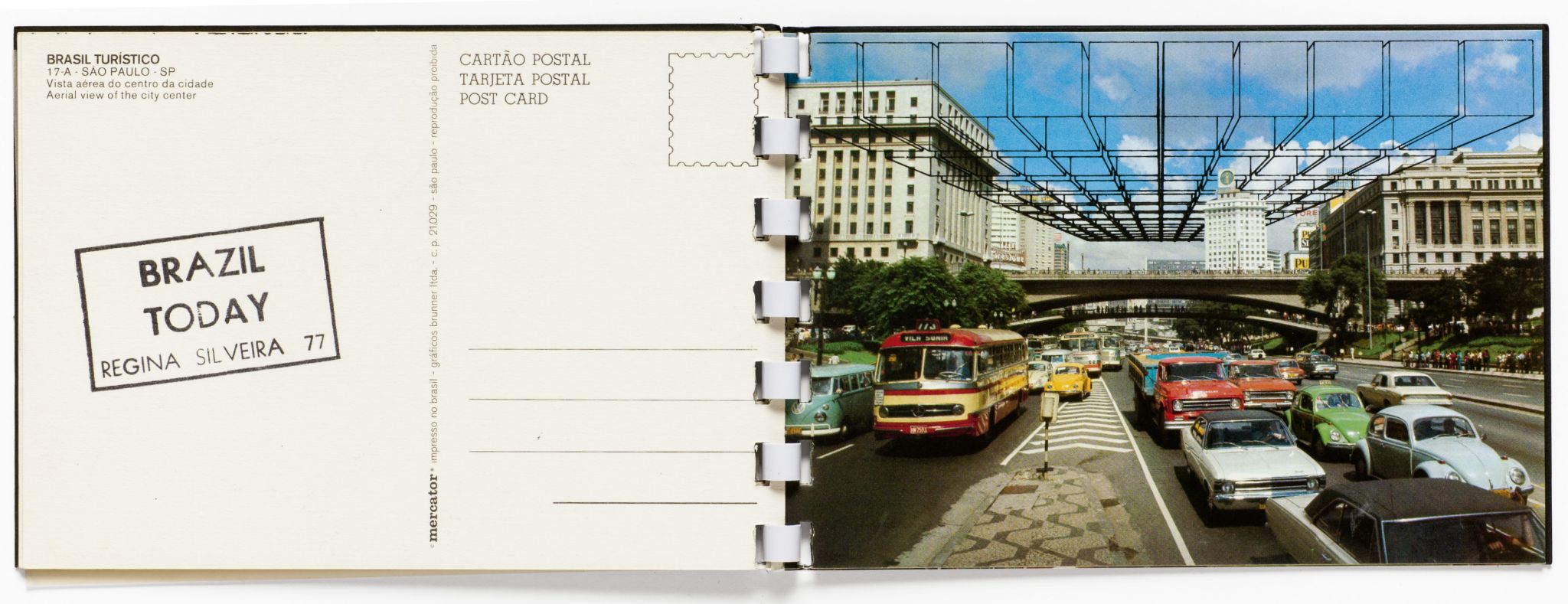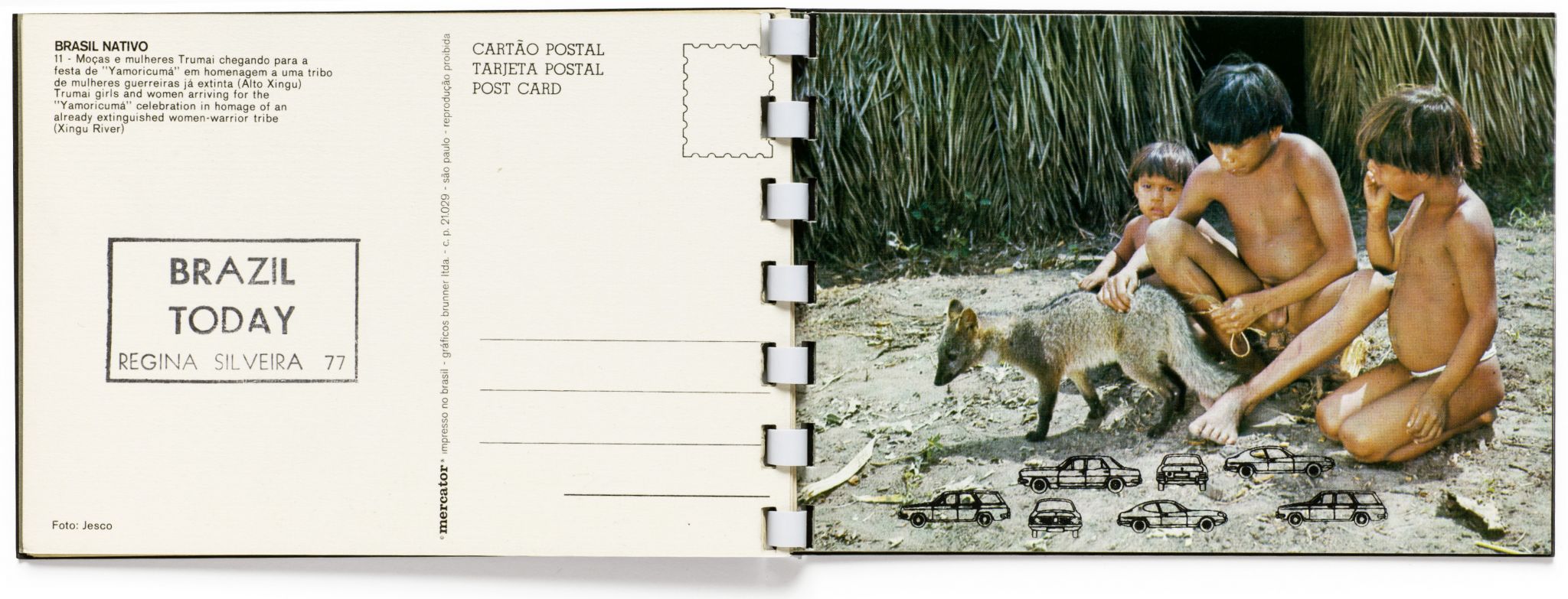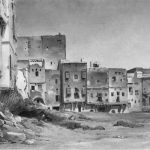The Art of Correcting Reality
Publicado em: 5 de August de 2015Brazil Today is a series of four postcards booklets with images altered by Regina Silveira in 1977: one is dedicated to natural scenes; the second, to cities; the third, to birds; and the fourth, to the native Indians of Brazil.
These 24 cards show Brazil in 1977 – which is pretty well the same, four decades later. A lot has changed since then (1977 was another violent year of the hard-line dictatorship), but much that has changed just confirms what Lampedusa wrote in The Leopard, seen here first as a Visconti film in the 1960s: everything must change so that everything remains the same. Just to glance at any of the postcards is to see an image of Brazil that is as much of the present as of 1977 – the wreckage of urban culture, piled up everywhere; the vultures and buzzards over Brasília; the cities all boxed up by their unformed grey buildings, surrounded by cars, and native Indians, obliged to look just as they are expected to look, as part of our “historical heritage”. This sense of an eternal present that creeps along over the decades is existentially distressing for those who live in the country today. However, the idea that art from that period is still contemporary art is aesthetically comforting. Museums and collectors from abroad understand that, as they run after works from the 1970s, having exhausted the springs of the 1960s. Brazil Today benefits from an undue advantage, yes: the country of which it speaks is another but yet it is still the same. But the problem lies with the country, not with art.
Inspired by a tourism supplement of the same name published by the weekly magazine Manchete, Regina Silveira put together four booklets of postcards she purchased at São Paulo’s domestic airport, Congonhas – near where she lived and which was still civilized at the time. Regina tells us that she was only able to buy what was absolutely necessary – there was little money around and artists turned their back on the market, not expecting the state to do what the market wouldn’t. Losing a postcard or anything else by mistake or carelessness was a minor economic drama. Enlargements were made from the postcards and the artist made her interventions on these copies. The results were reformatted (a word that did not exist at the time) back to the original size and the workthat- was-not-a-work was then screen printed and spiral bound by the stationery shop on the corner. The artist’s raw materials were the photograph itself, her own sketches, the fantastic Letraset transfer sheets (the designers’ delight before the computer age) and other images taken from books and catalogues. With these to hand, she set to work, using anamorphosis, distorting the images from newspapers, magazines or well-known art works, overlaying them with unexpected shadows – defacing, reconfiguring, playing with light and its opposite.
That was the heyday for appropriating images from another source and applying “critical interventions” to them, as the artist herself says. The “graphic imagery” that was available, already immense in its variety although tiny compared to today, was invariably mediated using photomechanical matrixes transposed to other media and then critically altered – in Regina’s case mockingly and corrosively. Photographs – both those of the postcard, a ready-made for Regina, and the others she added – were just raw material for the artist, a commodity, just like the iron ore and coffee beans that Brazil continues to export without adding value. A commodity both in the economic and common sense: a convenience for the artist. These photos were not chosen for their aesthetic or documentary value – it was enough that they registered a fact. Some came from her own postcards; others, such as those of the car cemeteries, were taken at her request by the artist Julio Plaza, her husband at the time. He was not, however, the author of the photos, only the imager. The photos were a ready-made, simple index – pure photography – alienated from the culture that generated them and in no position to assert themselves on that culture, to the extent that the credits on most of the postcards she used do not include the name of the photographer. In these images, there is no natural aesthetic or critical viewpoint – these were added by the artist, by hand, using Letraset and screen printing. It was not that different from the way other artists of the period, such as León Ferrari, Hélio Oiticica or Robert Rauschenberg, were using photography. Everything they used as a basis for their work had the same zero degree of aesthetic significance: the postcard, the workaday snapshot, the Letraset.
The fate of these cards was to become posted art – sent through the post (internet didn’t exist then) to artists and others, as a way of swapping artistic ideas and experiences – an example of the deviant aesthetic process. But that did not stop them from being shown in alternative exhibition spaces. Brazil Today was shown for the first time in 1977, at the University of São Paulo’s Museum of Contemporary Art, as part of the Poéticas visuais [visual poetics] exhibition. In 1978, they were included in the exhibition Printed in Brazil, organised by Regina Silveira herself (the figure of the curator did not exist then – not that many or in our contemporary usage; the artist, then, took an Olympian view and dispensed with the whole concept of curator, something she denies, but without conviction) and sent in an ordinary parcel to Other Books and So (that’s So, not Co) in Amsterdam. More recently, the set was seen at the Cartier Foundation in Paris, in the show Latin America – 1960-2013. The text by the exhibition’s curators did not address the issue of whether these works by Regina Silveira were “photography” or “about photography”, nor whether they had the right to be seen there: they thought that they were one aspect of the way photography could be used and that was enough – at least for art.
Even though it is not a political pamphlet, Brazil Today is acid in its viewpoint. And it shows an aesthetic meanness (malice) (Friedrich Schlegel), the kind of “logical beauty” also seen in artists like Nelson Leirner, Paulo Bruscky and Berna Reale. The Natural Beauties notebook (the titles are in English, as the magazine from which they come used English for the foreign readers) shows the ramp of the President’s offices in Brasília (Planalto), the Ipiranga Museum and the São Paulo Museum of Art (MASP) under mountains of junkyard cars, which are also seen piling in or out of a São Paulo subway car. (MASP is all apparent concrete, almost white as it was still so clean, and harmonious, without the red columns that the architect, in an allegorical outburst, imposed on it later. Should listed buildings be protected against the errors of their creators?) In another booklet, buzzards, vultures and other birds of ill omen fly over Rio and Brasília. In the cities booklet, all the images are of São Paulo, as an emblem for all Brazilian cities. Regina Silveira’s work was not travel journalism, but a work of art which at the time was not really a work nor art. These cities are seen under a reticulated mesh that hangs like a threat above or in fragments, stored in transparent rectangular boxes, all the same and uniformity-imposing. She does similarly to enclose the native Brazilians in Indians from Brazil, who are also arranged within mazes, a recurrent symbol in the artist’s work. In this same series, she extends the visual resources she uses to include images taken from the innovative Letraset transfer sheets – a postcard, two identical male figures wearing hats, suits and ties and carrying the then ubiquitous 007-style briefcases are superimposed on a single line of Indians wearing ceremonial costumes. The effect is ironic and poignant. As in the other three booklets.
This was another view of art, an art-not-art which had difficulty in actually being not-art, trying to position itself as both alternative art and “art” at the same time. A paradox. No matter, art has always lived with paradoxes, and Regina Silveira’s work is full of them. She herself distributed copies of her own and other works of the time at the entrances to metro stations. These included the pamphlet Pudim da arte brasileira [Brazilian art flan], a powerful slap on the cheek for the local “national art” ideologues, who were obsessed about finding solid roots for their ideas all over the place, at a time when everyone knew that roots are always changing. Nowadays, the original typed version of Pudim is worth a bit (in real money, as the Argentinian León Ferrari said, referring to US greenbacks, not that one which is still circulating around with another name). Now these works from the 1970s are valuable, being acquired by MoMA and other first world museums (because the distinction still exists).
The social and political criticism of Brazil Today is clear and evident, although it is nothing like a political pamphlet – and so it is more effective and durable, and just as valid nowadays: the vultures continue flying over Brasília, São Paulo remains clogged up with all sorts of rubbish and old wagons disguised as cars, the Indians are still boxed in by imaginary anthropological and cultural heritage boxes. The relevance of these booklets is related to the way the artist creates the images. Whoever sees the image of a big, menacing black bird flying over the Transamazon Highway in the middle of enigmatic black lines pointing the way – making aerial pathways like the lines of a musical score – has little chance of finding out that these drawings are extracted from copies of Scientific American, where they illustrated the different types of bird flight – one of the many magazines the artist often uses to source her images. No matter: all this becomes an allusion – one that is sometimes enigmatic, but always with a powerful critical viewpoint – in the eyes both of that time and now. Contemporary art. In 1977, Regina Silveira challenged the rosy pink image of Brazil promoted by the military dictatorship, which actually imprisoned those who “denigrated Brazil abroad.” These same postcards keep still challenging the contemporary image of Brazil – looking forward, backward and prophetically. ///
Brazil Today (1977), screen printing on postcards. 10.5 × 15 cm.
reproduction: Nino Andrés. Omar Khouri collection.
Regina Silveira (Porto Alegre, 1939), an artist with a long teaching career, has appeared in individual and collective exhibitions since the 1960s, in Brazil and abroad. In her work, graphic works in different media predominate, together with installations and urban interventions.
Teixeira Coelho (1944) was a Director of MAC-USP and chief-curator for Masp. He is the author of A Cultura e Seu Contrário [Culture and its opposite], among other works.
///
Get to know ZUM’s issues | See other highlights from ZUM #8 | Buy this issue


